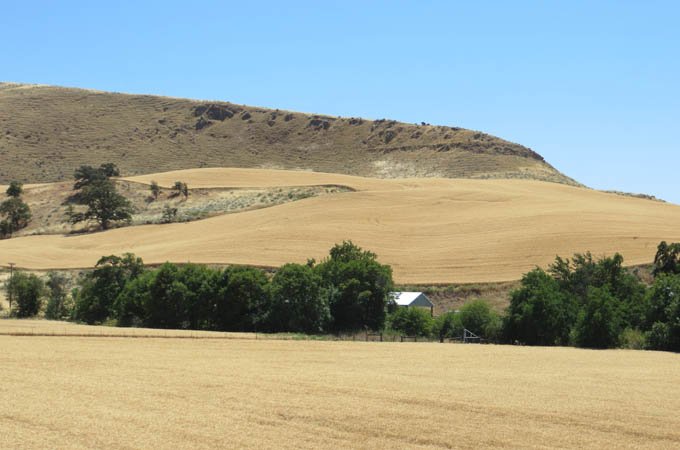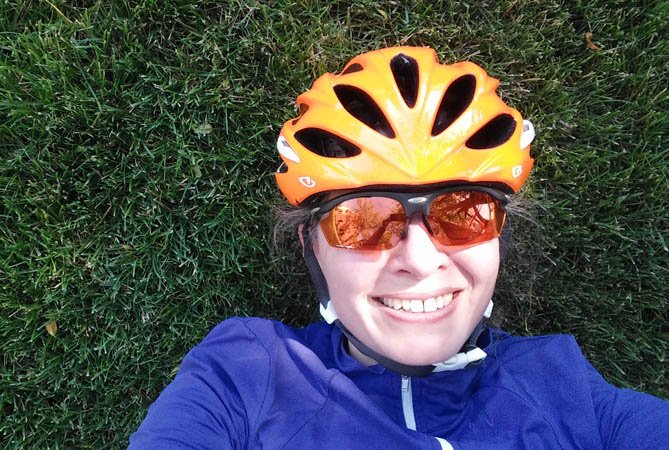Points in Time - car-free from Portland to Dufur
Dufur, Oregon, is a tiny town steeped in history – some of it car-free – and located approximately 100 miles east of Portland (following major auto routes). Dufur was a stop along the Oregon Trail, specifically the Barlow Road, which took westward traveling pioneers over the shoulder of Mt. Hood. Today, Dufur is off the main transportation routes. It’s just enough out of the way to feel away without being impossible to reach.
There’s a historic three-story brick hotel in Dufur, the Balch Hotel, a fine place to stay a few nights. I tried a new car-free travel experience from Portland to get there.
Until this year, a car-free trip to Dufur was out of reach for me, a Portlander who gets around principally by bike and transit. My recreation transportation usually involves a bike or carpool or a train and bike combination. Call me crazy – many people do – I love riding my bike alone in unpeopled, out-of-the-way places.
Columbia Gorge Express stop at Portland’s Gateway Transit Center
Columbia Gorge Express
In June, the Columbia Gorge Express began daily service, which addresses two car-free transportation gaps that enable me to reach Dufur: 1) transit service that allows for convenient travel with a bike that connects Portland to Hood River; and 2) transit service that runs mid-week. First, despite my relatively high tolerance for uncomfortable road conditions, I was not willing to pedal the infrastructure gap between Cascade Locks and Hood River. Second, I love that the Columbia River Gorge National Scenic Area is a popular destination for visitors, and I much prefer traveling mid-week when there are fewer people and fewer cars. So, I took Columbia Gorge Express from Portland on a Thursday morning to Hood River. Easy!
View of the Columbia River from the Historic Columbia River Highway State Trail
The bike ride from Hood River to The Columbia Gorge Discovery Center and Museum in The Dalles rocks. Four and a half miles of the route are car-free and the rest of it loops through the landscape. Builders of this road, the Historic Columbia River Highway, created the first scenic highway in the United States in 1922, and it is now a National Historic Landmark. Road waysides provide expansive views of the Columbia River and the area’s geology. Many of the Gorge’s unique landforms were deposited, shaped, or made visible during ice age floods.
Clock Tower Ales patio on a hot day
The Dalles is the largest Gorge community, with over 10,000 residents. I pedaled into downtown right at noon and must have encountered the lunch rush. I pulled over to get my bearings and consider an alternate route through town with fewer cars when I noticed Clock Tower Ales across the street. I knew I had 20 miles of climbing ahead of me, so I stopped for greens, shade, and cold beverages. A fleet of roadies appeared, about 15 lycra-clad men and women with spotless bikes. I wanted to know where they came from, but we didn’t chat.
With the ambient air temperature intensifying (it was in the 80s someone later told me, but it felt more like the 90s), I continued on quickly, knowing that this sunny region would feel hotter once I left the protection of the patio shade. Nearly east of town, I looked out at the river – the bridge over the Columbia, The Dalles Dam, and some shed-sized, weathered wood buildings. The buildings are the remains of an American Indian village. Celilo Falls, or Wy-am, is east of The Dalles eight miles, and when the dam was built in 1957, this traditional fishing area that for thousands of years served as a commerce center flooded in fewer than five hours.
East of The Dalles, I explored roads that were new to me. Eight-Mile Road appeared to be part of the original US 30 construction or an off-shoot of it. The road meandered around the hills, following Eight-Mile Creek and climbing gradually. I enjoyed the sense of enclosure created by the hills and trees, and while the sun shone hotly, pockets of shade offered some relief. Old barns and wildlife added scenic appeal to this stretch of road built in 1922.
Six-ish miles from Dufur, my route connected with Highway 197 – a wide, hot, treeless and straight expanse that went up. My map indicated that it would be a big climb from The Dalles to Dufur. I pedaled and sweated and wondered if the heat would do me in. At long last, a right lane merge sign suggested I would soon reach the top of the climb! I squeezed hot water from my water bottle over my shoulders and let it drip down my sides and legs. There was enough breeze and, thankfully, tailwind that the water helped cool me. At the top of that big climb, I rolled downhill briefly before another climb came into view. I distracted myself by watching the wind ripple and rustle the wheat fields.
In no time, I rolled downhill into Dufur and came to a stop under some trees in the Balch Hotel garden where I promptly dismounted and lay in the shade. I considered that the ride between The Dalles and Dufur would be much more pleasant earlier in the day or great any time of day in the spring or fall.
To my great delight, my room at the Balch came with little chocolate squares. When I descended to the main floor at dinnertime for made-on-site organic salads and light fare (and special weekend entrées), I found mini homemade chocolate chip cookies at the reception desk and an amply stocked tea bar with coffee. I helped myself.
I slept well and, the next day, finished reading The Orchardist after visiting the Dufur Living History Museum. At the Museum, I learned that Dufur had been a thriving fruit producing area in the 19-teens, but by 1922 the fruit operation folded. The available water in the Wenatchee area, where The Orchardist is set, made better fruit than what could be grown with irrigation in Dufur.
As part of my experience at the Living History Museum, a member of the Dufur Historical Society who’d lived in Dufur “since forever” broke out his mandolin and played “She’ll Be Coming Round the Mountain.” I chuckled. She came by transit and bike.
For more information about car-free travel in the Gorge, visit ColumbiaGorgeCarFree.com. To try the Hills, Hotel and History car-free experience from Portland to Dufur, click here.
Evening at the Balch Hotel garden












